Baby, it's Cold Outside!
Charging an EV when the temperature plummets - and should Rapid Chargers be limited to 80%?
Beautiful, isn’t it?
This year I decided to drive the 750 miles from my home in Scotland to my Mum’s place near Dover for Christmas. As I’d be staying in Mum’s house, I didn’t want to take the caravan and pay for a site just to leave it empty.
After two and a half days of driving and two overnight stops in hotels, all I can say is:
Thank goodness I did not try and take the caravan!
Cold Comfort
I love winter caravanning, but by that I mean going to a place, staying there a while, then going home. Caravan touring in the winter, on the other hand, is way more challenging than caravan touring in the summer.
For a start, there are way fewer site options in the winter as most sites, especially those in Scotland, close their gates between autumn and spring. Nobody likes setting up in the dark. Combine the extra time needed to set up and warm the caravan on arrival with the shorter days of winter, and you’ll soon realise that a three day journey in June becomes a five or six day journey in December. On top of that, you have additional challenges if you are driving an EV in freezing conditions.
Joy!
My drive from the Isle of Skye to Dover started off as a complete joy. The sky was blue, the sun shining, the snow crisp, and the roads clear. Scotland at any time of the year is stunningly gorgeous, but Scotland cloaked in snow on a bright and sunny winter’s day is off-the-scale ridiculous.

Everything was hunky dory, but I made the schoolboy error en route of topping up my windscreen washer tank with plain water, as the light came on but there wasn’t a garage around for miles from which to buy windscreen washer fluid. Go on, smart EV drivers, put your heads in your hands.
On long journeys with my old diesel truck, popping plain water in the windscreen washer tank as a short-term measure never caused a problem, as the heat from the engine soon defrosted any overnight freezing.
Of course, if there is no engine, then there is no heat, and there is no defrosting of the windscreen washer pipes. The following day I needed to stop the car to clean the windscreen every 15 minutes until I found a Halfords. Numpty!
Halfords only had some strange cherry flavoured windscreen washer additive available, but beggars can’t be choosers. I can’t help but think that giving toxic pink fluid a strong cherry flavour could only end in disaster should the bottle end up in the wrong hands.
Frozen pipes were the least of my worries though. Nobody had clearly explained - or I simply hadn’t listened - about just how grim the charging experience would be with the temperature well below zero.
Slow and not so steady
I’d not really given much thought to charging in the winter. After all, EV ownership is rife in Norway, and those canny Scandis know a thing or two about seriously cold weather.
However, as many of you will know, as soon as the UK has any kind of weather that deviates from mild, grey, and damp, all kinds of infrastructure fall apart. That, I discovered, includes the charging infrastructure.
My first shock was at the Ionity Ultra-Rapid Chargers at Gretna Services. I’d used these before in the summer and managed to pull an astonishing 230kW, charging my battery to 80% in about 15 minutes.
On this particular December night I was hungry, tired, and more than ready to be settling in to a warm hotel room a further 45 minutes away at Penrith.
At eight o’ clock on a Sunday evening it surely wouldn’t be too busy, right? Wrong. I was the second car waiting in the queue, and I ended up waiting over half an hour for a post to become free. Frustrated, I looked at the output of each charger to see that nothing was delivering more than 60kW.
It transpires that when the mercury plummets, an EV’s Battery Management System will reduce the charge it demands quite dramatically, in order to protect the cold battery.
Instead of taking 15-20 minutes to charge to 80%, each car was taking more than twice that amount of time. This means that queues involve more cars, and the wait times are hugely increased.
While you are sat waiting for a charger, you can’t do anything or go anywhere. Not only might you lose your place in the queue if you’ve wandered off to use the loo or buy a sandwich, but it’s not fair on everyone queuing behind you if a charger is sat unoccupied while you’re polishing off a Whopper in the amenity building. Sometimes you might be able to work out roughly how long the wait will be, but only if every driver is with each car on charge and is willing to chat.
Nope, you just have to sit in the car and wait, watching other cars charge. It’s a bit like watching paint dry, but with the added frustration of being tired and hungry.
When my turn came, the car drew just 47kW instead of the expected 230kW. NOW I could go and get something to eat, but the layout of Gretna Services puts the Ionity chargers a long walk from the amenity building, and as I was only topping up from 50%, there wasn’t the time to sit and enjoy a hot meal. The irony.

The entire charging stop took an hour, yet by the way that hour was chopped up, there was insufficient time for the solo traveller to get any hot food.
Put simply, unless your car can condition your battery by pre-warming it, an Ultra-Rapid Charger is if no more use than a Rapid Charger.
It wasn’t all bad
At one charging stop half way down the country, the wait was a mere 10 minutes, and there was a warm and inviting dog-friendly Starbucks next door. Dougal and I could enjoy a proper break, a warm meal, a hot drink, and a gentle conversation with a lovely fellow EV driver. This is how every charging stop should be - maximising your time when you’d be stopping anyway.
Of course, it all fell apart again at Beaconsfield M40 where the wait was 15 minutes, but this was caused partly by selfish EV owners charging their vehicles to beyond 80%. Which leads me to the following question:
Is it time for an 80% Limit on Ultra-Rapid Chargers?
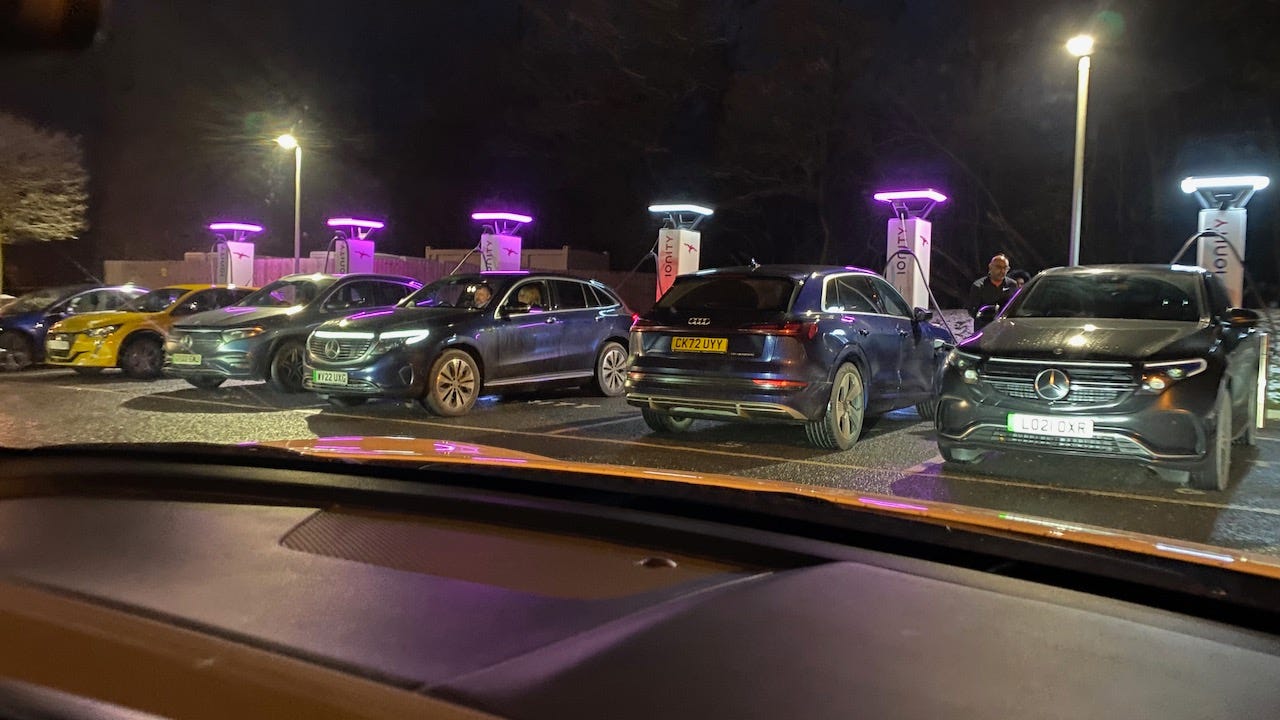
The rate of charge at a Rapid or Ultra-Rapid Charger slows considerably after the battery reaches 80%, in order to protect said battery. Recently in Benbecula I waited over 30 minutes for a BMW to get from 97% to 100% on a 50kW Rapid Charger.
The excuse I hear the most from people charging beyond 80% is:
Oh, but I don’t want to have to stop again on my journey.
In other words, they think it’s fine to make everyone else wait a disproportionately longer time just so they themselves don’t have to make another quick charging stop.
I would personally welcome a charging limit of 80% on Rapid and Ultra-Rapid Chargers, enforced by the machine itself. If people want to go beyond that, then they might use an AC Charger which would fill up the battery at a similar gentle rate as a strangulated Rapid Charger.
Do you agree or disagree? Let me know in the comments.
Festive Greetings
Yes, it’s that time of the year again. Although Electric Touring has only been around for a few months, I’d still like to take a moment to reflect and sincerely thank each and every one of you for your support. I hope you have found some value in what you have read, and it’s helping you make your own decision about whether or not Electric Touring is for you.
Did you find value in this edition of Electric Touring?
If so, please subscribe and join the growing community of people who tour with EVs, or are interested in doing so.
✓
Sharing is caring
I’d be really grateful if you could share this Newsletter with your friends online, on your social media platforms and on relevant forums that you enjoy.
Feeling Flush?
Electric Touring is self-funded and therefore completely independent. There are no adverts to spoil your experience. If you’d like to support us, and you’re in a position to do so, please consider Buying Me a Coffee using this link:
https://www.buymeacoffee.com/andrewditton
THANK YOU for your support.
About the author
Andrew Ditton is an award-winning videographer and leisure vehicle journalist with over 20 years experience. His audience is one of the largest and most engaged in the sector (source - Semrush) and his YouTube channel has over 73,500 Subscribers (December 2022).

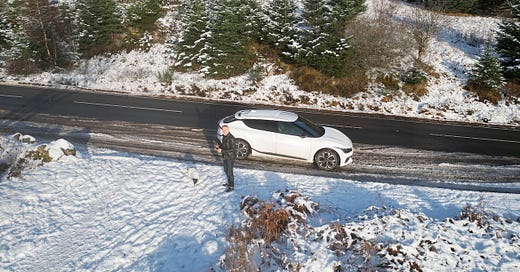



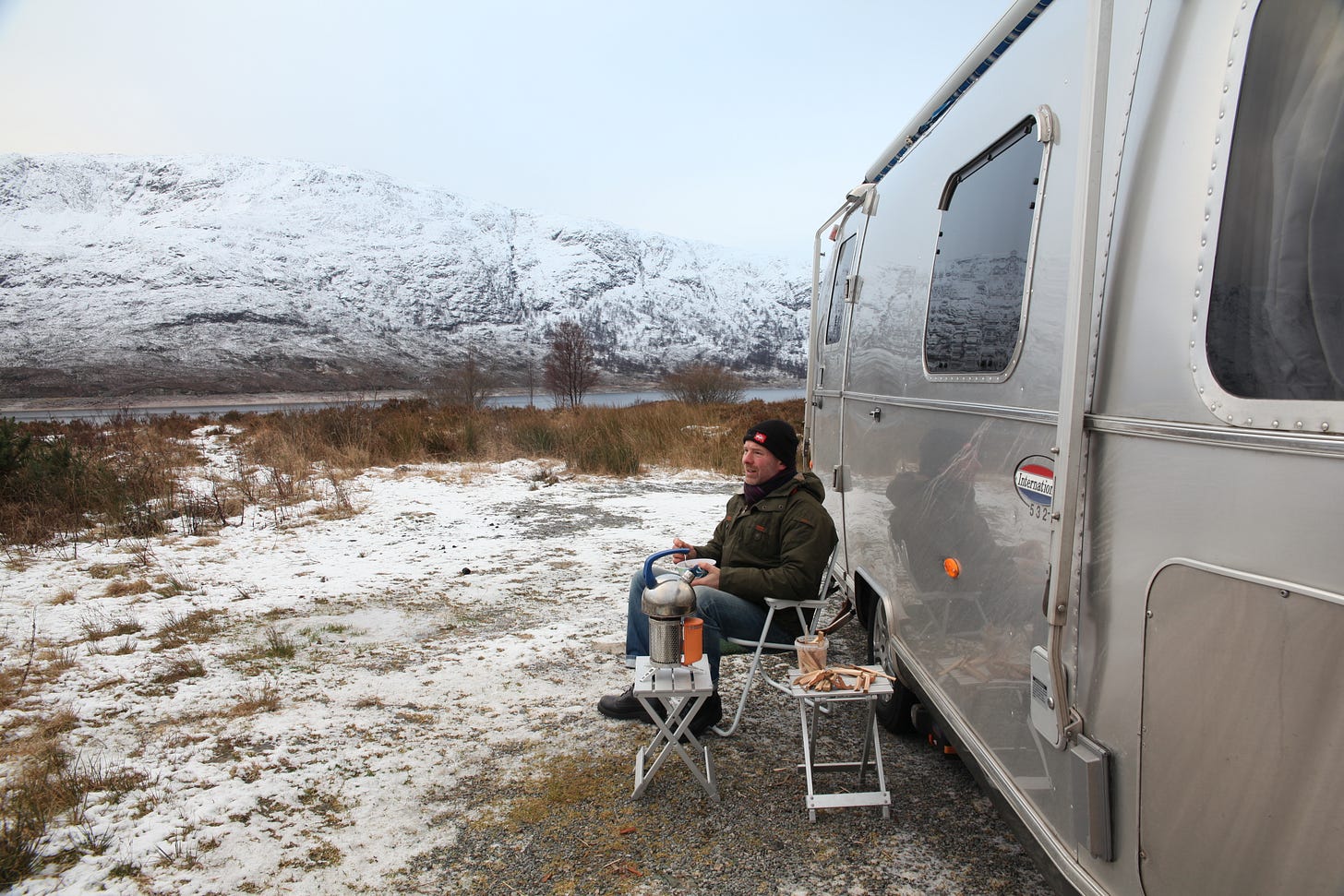

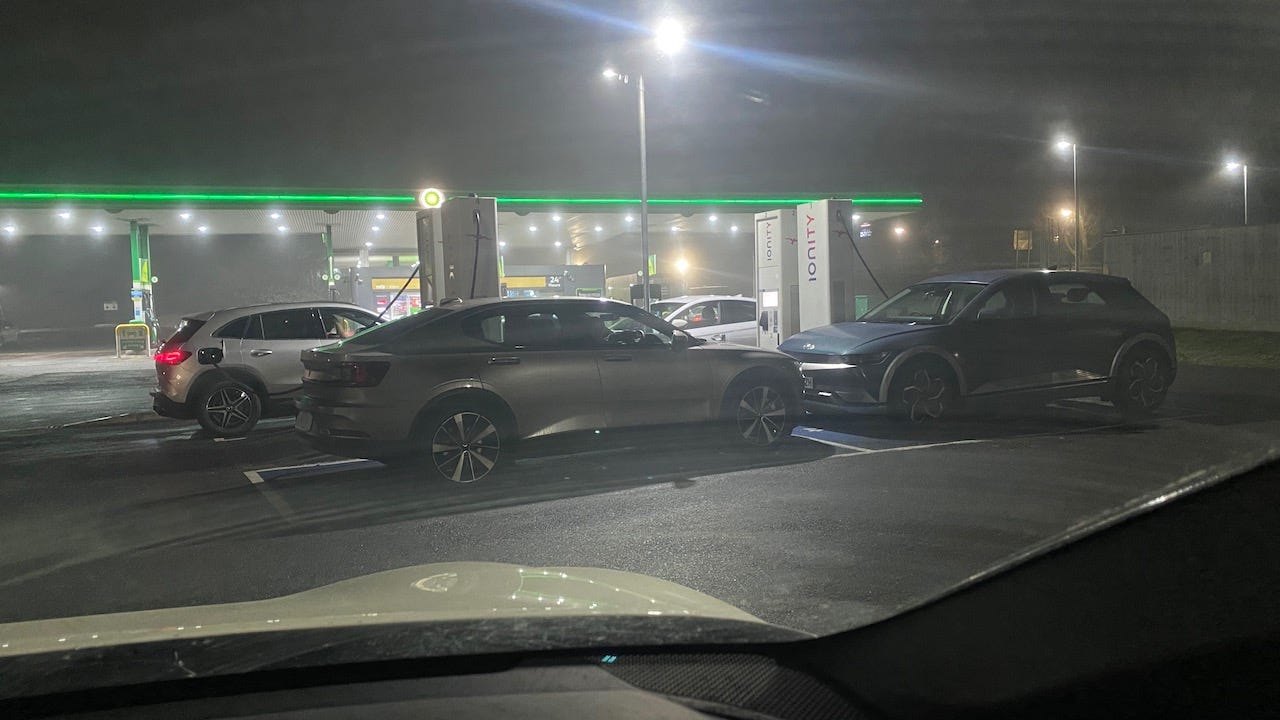


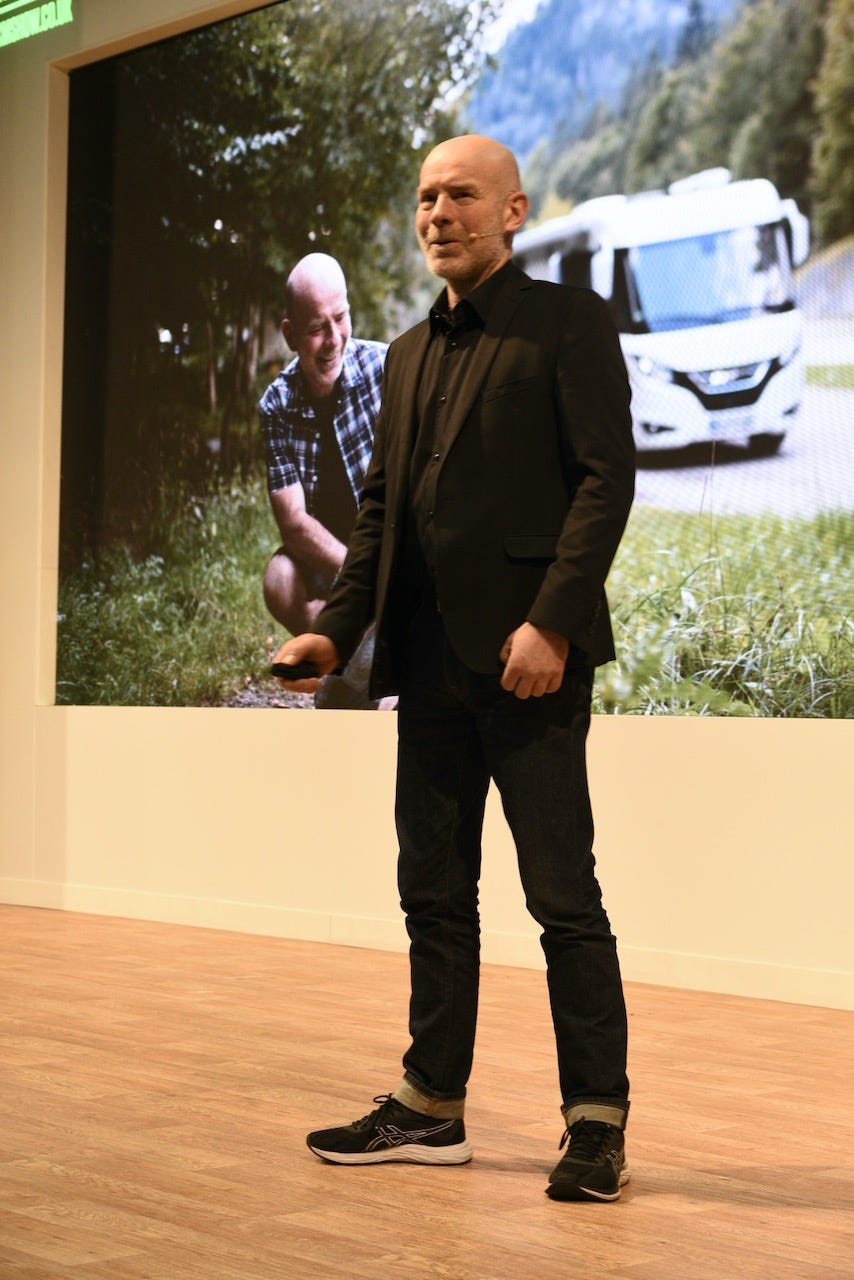
Very interesting read thanks. I’m still waiting on my Enyaq :-( so we rented a Mercedes eqb for our Xmas family expedition to Germany and Belgium. We were lucky and missed the very cold snap. We only had to queue once (nearly all IONITY chargers on our trip) and that was back in the U.K. (Kent) good humour and we were on charge quickly enough and I stopped at just past 80%. We found the eqb charged even up to 95% at 45-50kw so worth hanging on an extra 5 mins - and with no one else around that makes sense. I think more could be added to the apps such as registering into a queue and getting texts when you’re next in line and say the current cars are getting to 80% and kicking people off if and only if there is a queue.
My husband used to put a teaspoonful of washing-up liquid in the washer bottle and it never froze.